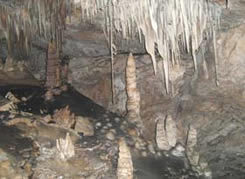
|
| ©Jesus Pajon |
Every now and then, Jesus Pajon, a researcher with the Archaeology Department of the Cuban Anthropology Institute and head of the paleo-climate- Archaeology scientific project, puts on his "armor" to take samples of the waters that seeps through the walls of the Majaguas-Cantera cave system, at the San Carlos mountain range, in western Pinar del Río province.
The purpose of these incursions, which take place monthly or bimonthly, is to analyze the chemical characteristics and other parameters of these cave waters, a monitoring process carried out with the cooperation of the Institute of Environmental Physics of the Academy of Sciences in Heilderber, Germany, particularly of professor Augusto Mangiri.
The data collected is very useful when evaluating if speleothemes (they include the well known stalagmites and stalactites and other types of cave formations) present in the area's underground caves are the right ones at the time of continuing the paleo-climatology initiated ten years ago in this sector of western Cuba by different institutions of the Ministry of Science, Technology and the Environment.
Source of Knowledge
Pajon says that climate on the planet has never been stable; it has varied throughout time, and will continue to do so in the future, beyond any influence of human activity.
In view of the strong evidence that a process of global warming is underway, it is important to find out how temperatures and other variables of the different periods of Earth evolved. This is the essence of paleoclimatology: to study climate of past eras, taking geological indicators as a starting point, said Pajon.
"The more data we have in this regard, the better possibilities for scientists to calculate, more objectively, the real impact of man's actions on today's environmental conditions and to model probable future scenarios."
Pajon explained that speleothemes, and particularly stalagmites, are a kind of natural archive of great value to study global climate changes, since variations in the composition or the activity of oxygen isotopes are registered on its rings or strips of annual growth, which takes place only if notable changes in climate have occurred.
The San Carlos mountain range is perhaps one of the most important spots of the world's tropical regions to carry out these works, since it has a wide gamut of stalagmites, from ancient ones to young ones, said Pajon.
"By way of the application of geochemical methods and techniques of stable oxygen isotopes and by radiocarbon and uranium-thorium dating, we can determine that there has been a general tendency toward climate warming in our archipelago between the last Maximum Glacial that occurred 18,000 years ago and the present time."
Another interesting result of this project carried out in coordination with researchers Luis Raul Paz, Abel Centella and Ramon Perez, from the Meteorology Institute, is obtaining, for the first time in Cuba, paleotemperature curves corresponding to the last 15,000 years.
In accordance with these observations, the average value of temperature for this mountainous area of western Cuba has increased between 8 and 10 degrees Celsius during that period.
Also on the increase is the occurrence of extremely sudden climate change with a six to eight degree increase of average temperature in scarcely two millenniums, which it seems to have taken place between 11,520 and 9,220 years before present; registers that coincide with reports on stalagmite studies made in other parts of the world.
As Pajon states, at that time, there was a rapid transition at a global level, from typically glacial conditions (the advance of large masses of ice to medium latitudes and the subtropical area) to interglacial ones, characterized by the fusion and withdrawal of these ice masses due to the continuous increase of temperatures.
Cuba's geographical location, under the influence of the atmosphere-Earth-ocean interconnection between the Northern and Southern hemispheres, makes it the perfect place to investigate the influence of glacial and interglacial periods on tropical and subtropical regions and help piece together the jigsaw of past climates.



Reader Comments
to our Newsletter